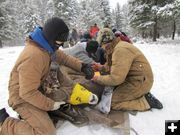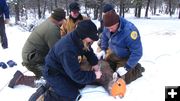

Collecting health samples
Agency workers and volunteers from the local community collect health samples from bighorn sheep on January 12 on the Woods Ranch Wildlife Management Area near Eureka. Montana Fish, Wildlife & Parks courtesy photo.
|


Blood sample
FWP Wildlife Program Manager Neil Anderson holds a bighorn ewe while Wildlife Disease Ecologist Emily Almberg prepares to take a blood sample on January 12 on the Woods Ranch Wildlife Management Area near Eureka. Montana Fish, Wildlife & Parks courtesy photo.
|
|
Capture and health testing conducted on bighorn sheep herd near Eureka
by Montana Fish, Wildlife & Parks
January 16, 2017
Montana Fish, Wildlife & Parks (FWP) biologists and volunteers from other agencies and the local community captured and released 32 bighorn sheep on the woods ranch wildlife management area near eureka. The captured sheep were a mixture of ewes, lambs, and rams. The operation is designed to obtain health information on the population. The sheep are part of the Galton range herd that occupies land in the u. S. And Canada; the Canadians refer to this group as the "Kootenay Trench herd". These sheep are part of a native herd and believed to be similar genetically to the Ural Tweed population along Lake Koocanusa.
The sheep were captured with a large drop net suspended from poles. The sheep are drawn to the site with hay, and then the net is dropped over them. Biologists and volunteers then hobble and blindfold the individual sheep so they can be processed. Ten sheep were captured and processed in the morning, and 22 were processed in the afternoon. Two large rams, one weighing 285 pounds, were captured.
The sheep are tested for respiratory pathogens such as mycoplasma ovipneumoniae, and various bacteria belonging to the pasteurella group. These pathogens can cause pneumonia. Also included in the testing is exposure to respiratory viruses and parasite loads (such as lungworm). Blood, nasal swabs, and tonsil swabs are collected for testing and temperature is monitored. An ear tag is attached to each sheep. The testing is important for monitoring the health of this unique herd of native bighorns. The health information is also important if the sheep are to be used for augmenting other sheep herds.
Additional bighorn sheep herd health operations will be focused on herds in hunting districts 121 (north Clark Fork), 122 (Clark Fork Cutoff), and 101 (ural-tweed along Lake Koocanusa (Libby Reservoir)). Bighorns in the Paradise herd (hd 124) were captured last month as part of a statewide research effort to learn more about how diseases function in bighorn sheep populations.
|